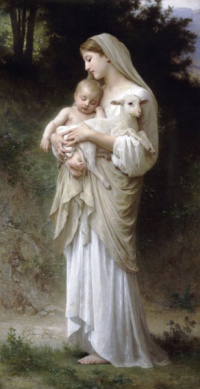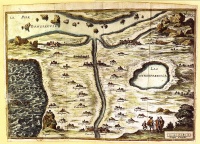Love
From The Art and Popular Culture Encyclopedia
| Revision as of 20:17, 4 January 2014 Jahsonic (Talk | contribs) ← Previous diff |
Revision as of 20:18, 4 January 2014 Jahsonic (Talk | contribs) Next diff → |
||
| Line 11: | Line 11: | ||
| {{Template}} | {{Template}} | ||
| - | '''Love''' refers to a variety of different [[feeling]]s, [[Mental state|state]]s, and [[attitude]]s that ranges from interpersonal [[affection]] ("I love my mother") to pleasure ("I loved that meal"). It can refer to an [[emotion]] of a strong [[interpersonal attraction|attraction]] and personal [[attachment (psychology)|attachment]]. It can also be a [[virtue]] representing human [[kindness]], [[compassion]], and affection—"the unselfish loyal and benevolent concern for the good of another". It may also describe compassionate and affectionate actions towards other humans, one's self or animals. | + | '''Love''' refers to a variety of different [[feeling]]s, [[Mental state|state]]s, and [[attitude]]s that ranges from interpersonal [[affection]] ("I love my mother") to pleasure ("I loved that meal"). It can refer to an [[emotion]] of a strong [[interpersonal attraction|attraction]] and personal [[attachment (psychology)|attachment]]. It can also be a [[virtue]] representing human [[kindness]], [[compassion]], and affection. It may also describe compassionate and affectionate actions towards other humans, one's self or animals. |
| Ancient Greeks identified four forms of love: kinship or [[familial love|familiarity]] (in [[Ancient Greek|Greek]], ''[[storge]]''), [[friendship]] (''[[philia]]''), sexual and/or [[romance (love)|romantic desire]] (''[[eros (concept)|eros]]''), and [[Kenosis|self-emptying]] or divine love (''[[agape]]''). Modern authors have distinguished further varieties of romantic love. | Ancient Greeks identified four forms of love: kinship or [[familial love|familiarity]] (in [[Ancient Greek|Greek]], ''[[storge]]''), [[friendship]] (''[[philia]]''), sexual and/or [[romance (love)|romantic desire]] (''[[eros (concept)|eros]]''), and [[Kenosis|self-emptying]] or divine love (''[[agape]]''). Modern authors have distinguished further varieties of romantic love. | ||
Revision as of 20:18, 4 January 2014
Illustration: The Birth of Venus (detail), a 1486 painting by Sandro Botticelli


|
Related e |
|
Featured: |
Love refers to a variety of different feelings, states, and attitudes that ranges from interpersonal affection ("I love my mother") to pleasure ("I loved that meal"). It can refer to an emotion of a strong attraction and personal attachment. It can also be a virtue representing human kindness, compassion, and affection. It may also describe compassionate and affectionate actions towards other humans, one's self or animals.
Ancient Greeks identified four forms of love: kinship or familiarity (in Greek, storge), friendship (philia), sexual and/or romantic desire (eros), and self-emptying or divine love (agape). Modern authors have distinguished further varieties of romantic love.
Stendhal, in his book On Love (Paris, 1822), distinguished carnal love, passionate love, a kind of uncommitted love that he called "taste-love", and love of vanity. Denis de Rougemont in his book Love in the Western World traced the story of passionate love (l'amour-passion) from its courtly to its romantic forms. Benjamin Péret, in the introduction to his Anthology of Sublime Love (Paris, 1956), further distinguished "sublime love", a state of realized idealisation perhaps equatable with the romantic form of passionate love.
Non-Western traditions have also distinguished variants or symbioses of these states. This diversity of uses and meanings combined with the complexity of the feelings involved makes love unusually difficult to consistently define, compared to other emotional states.
Love in its various forms acts as a major facilitator of interpersonal relationships and, owing to its central psychological importance, is one of the most common themes in the creative arts.
Love may be understood as a function to keep human beings together against menaces and to facilitate the continuation of the species.
Contents |
Romantic love as a form of mental illness
“The language of Valentine's Day cards and love songs-‘crazy for you,’ ‘madly in love,’ says Frank Tallis, author of ‘Love Sick: Love as a Mental Illness’ point to love as a mental illness
Further reading
- The Symposium (360 B.C.E) - Plato
- On Love (1822) by Stendhal
- Falling in Love (1979) by Francesco Alberoni
- Essays in Love (1993) by Alain de Botton
See also
- Amatory fiction
- Amour fou
- Cult
- Desire
- Eros
- Erotophobia
- Free love
- Interpersonal attraction
- Intimate relationship
- Greek words for love
- Joy
- Liebestod
- Love-hate relationship
- Love letter
- Love scene
- Love sickness
- Love song
- Love magic
- Love is blind
- Lust
- Madonna-whore complex
- Narcissism
- Philia
- Platonic love
- Romance novel
- Romantic friendship
- Romantic love
- Romeo and Juliet
- Sexual revolution
- Unreason
- Unrequited love
- Venus
Namesakes
.jpg)



